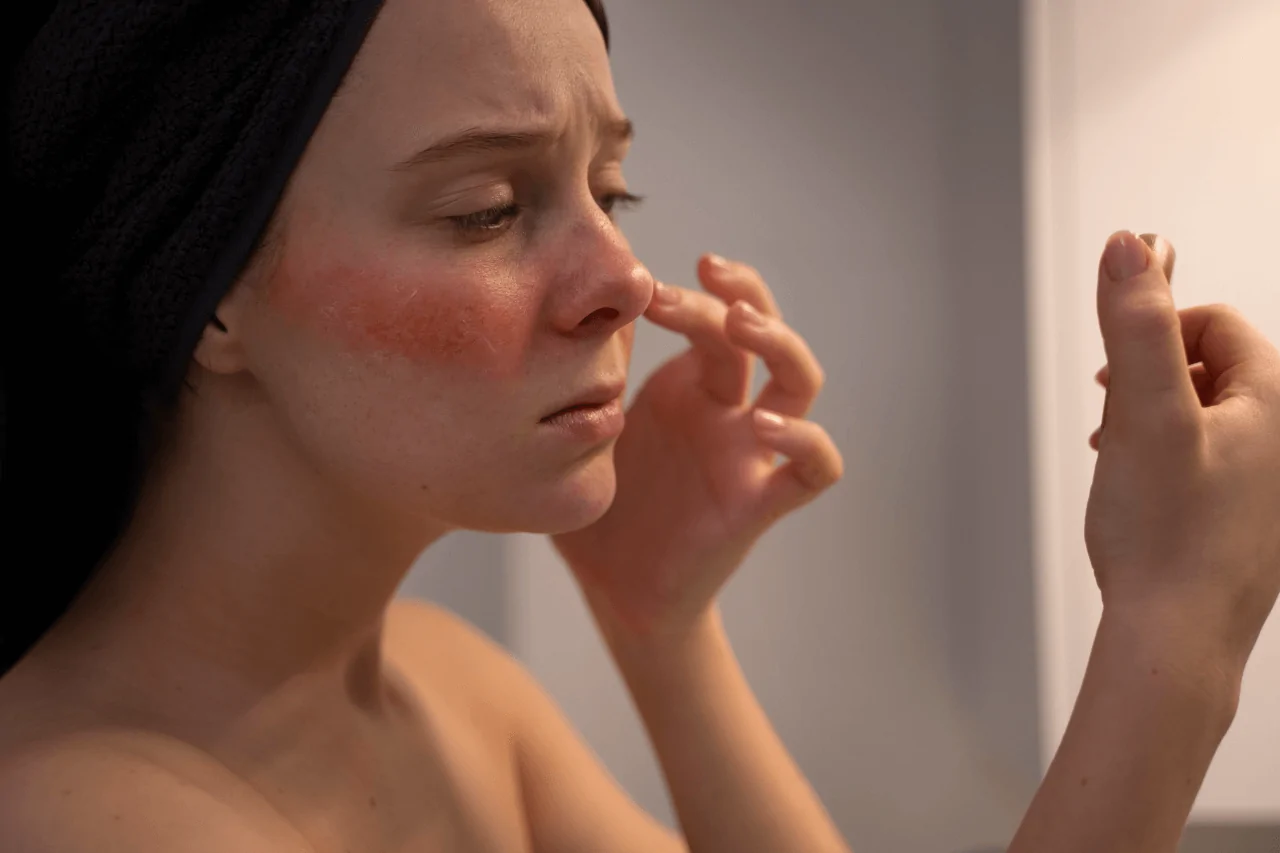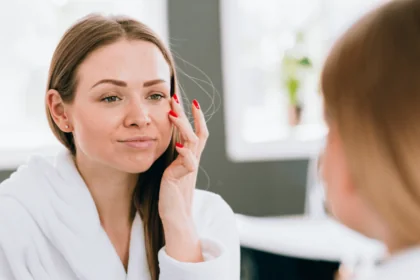Rosacea is a long-term skin condition that typically affects the face. It causes redness, pimples, swelling, and small blood vessels on the nose, cheeks, forehead, and chin. Sometimes a red, enlarged nose may occur in severe disease, a condition known as rhinophyma.
The exact cause of rosacea is unknown, but it is thought to be due to a combination of factors, including:
- Genetics: Rosacea is more common in people with a family history of the condition.
- Environmental factors: Certain environmental factors, such as sunlight, wind, and extreme temperatures, can trigger rosacea flare-ups.
- Microbes: Some people with rosacea have an overgrowth of the Demodex mite, a microscopic organism that lives on the skin. However, it is not clear if the mite causes rosacea or if it is simply a bystander.
- Immune system: The immune system may play a role in rosacea, as people with the condition often have elevated levels of certain immune system cells.
Rosacea is not contagious. It is a chronic condition, but it can be managed with medications and lifestyle changes.
Rosacea have waves of flare-ups, often caused by a trigger, when the symptoms are more visible and disturbing, and other times of cooling down when you could barely notice it.
Rosacea flare-ups
Rosacea flare-ups refers to a sudden and temporary worsening of symptoms associated with rosacea.
Rosacea flare-ups can vary in severity and duration but typically involve an increase in these symptoms.
Common signs and symptoms of a rosacea flare-up include:
- Facial Redness: One of the hallmark symptoms of rosacea is persistent redness of the central face, such as the cheeks, nose, forehead, and chin. During a flare-up, this redness can become more pronounced and intense.
- Visible Blood Vessels: Some individuals with rosacea develop visible blood vessels (telangiectasia) on their facial skin. These blood vessels may become more prominent during a flare-up.
- Pustules and Bumps: Rosacea can lead to the formation of pustules (pus-filled bumps) and papules (small, red bumps) on the face. During a flare-up, these lesions may become more numerous and more inflamed.
- Burning or Stinging Sensation: Many people with rosacea experience a burning or stinging sensation on their skin, especially during a flare-up.
- Eye Symptoms: Ocular rosacea is a subtype of the condition that affects the eyes. During a flare-up, individuals with ocular rosacea may experience symptoms such as dryness, redness, itching, and a gritty sensation in the eyes.
- Swelling: Facial swelling, particularly around the nose, may occur during a flare-up.
- Triggers: Various factors can trigger or exacerbate rosacea flare-ups, including exposure to sunlight, hot or spicy foods, alcohol consumption, stress, extreme temperatures, certain skincare products, and more.
Identifying triggers for Rosacea flare-ups
Identifying triggers for rosacea flare-up can be a critical step in managing the condition effectively. Since triggers can vary from person to person, it’s essential to pay close attention to your own experiences and keep a journal to track potential triggers. Here are some steps to help you identify and manage your rosacea triggers:
Keep a Rosacea Journal:
Start a journal where you record daily activities, diet, skincare routines, and any changes in your rosacea symptoms.
Note the severity of your symptoms each day and any specific triggers you suspect might be responsible.
Pay Attention to Diet:
Some common dietary triggers for rosacea include spicy foods, hot beverages, alcohol (especially red wine), and foods high in histamines (e.g., aged cheese and fermented products).
Try to identify any patterns between your diet and flare-ups. Keep track of what you eat and whether it correlates with worsening symptoms.
Observe Environmental Factors:
Environmental factors can trigger rosacea. Note any exposure to extreme temperatures (hot or cold), wind, humidity, or excessive sunlight.
Pay attention to indoor environmental factors as well, such as heating, air conditioning, and exposure to irritants like smoke or strong odors.
Monitor Skincare Products:
Some skincare products and cosmetics can aggravate rosacea. Look for patterns between the use of specific products and flare-ups.
Consider using gentle, fragrance-free, and non-comedogenic skincare products designed for sensitive skin.
Be Mindful of Stress:
Stress is a known trigger for rosacea. Monitor your stress levels and look for connections between high-stress periods and flare-ups.
Practice stress-reduction techniques such as meditation, deep breathing exercises, or yoga.
Identify Allergies:
Allergies to certain substances or ingredients can exacerbate rosacea. Keep an eye out for any patterns between exposure to allergens and worsening symptoms.
Consider allergy testing if you suspect allergens may be contributing to your rosacea.
Consult a Dermatologist:
A dermatologist who specializes in treating rosacea can provide valuable insights and recommendations.
They may perform tests, such as patch testing, to identify specific allergens or irritants that trigger your rosacea.
Gradual Changes:
Keep in mind that identifying triggers may take time and patience. Rosacea flare-ups can occur days or even weeks after exposure to a trigger.
Be consistent with your journaling and make gradual changes to your routine to test potential triggers.
Once you have identified your rosacea triggers, the next step is to develop a personalized management plan.
5 Ways to Manage Rosacea Flare-Ups
Managing rosacea flare-ups involves a combination of lifestyle modifications, skincare routines, and, in some cases, medical treatments. Here are five ways to help manage rosacea flare-ups effectively:
-
Identify and Avoid Triggers:
- As mentioned earlier, keep a journal to identify specific triggers that worsen your rosacea symptoms. Once identified, make a conscious effort to avoid or minimize exposure to these triggers. Common triggers include spicy foods, alcohol, sun exposure, stress, and certain skincare products.
-
Use Gentle Skincare Products:
- Opt for gentle, fragrance-free, and hypoallergenic skincare products specifically designed for sensitive skin. Avoid harsh cleansers, exfoliants, and products containing alcohol, witch hazel, or fragrances, as these can irritate the skin.
- Cleanse your face with a mild, non-abrasive cleanser and lukewarm water, and pat your face dry with a soft towel. Avoid scrubbing or rubbing your skin vigorously.
-
Sun Protection:
- Protect your skin from the sun, as UV radiation is a common trigger for rosacea flare-ups. Apply a broad-spectrum sunscreen with SPF 30 or higher every day, even on cloudy days.
- Wear a wide-brimmed hat and sunglasses when you’re outdoors, and seek shade whenever possible.
-
Lifestyle Modifications:
- Make lifestyle changes to minimize stress, as stress can trigger rosacea flare-ups. Practice stress-reduction techniques such as meditation, yoga, or deep breathing exercises.
- Maintain a consistent skincare routine, and avoid over-exfoliation or harsh treatments that can irritate your skin.
- Be mindful of your diet. While individual triggers can vary, consider limiting your intake of spicy foods, hot beverages, alcohol, and foods high in histamines.
- Keep your skin cool by staying in air-conditioned environments during hot weather and using a humidifier in dry indoor spaces.
Remember that Rosacea is a chronic condition, and there is no cure, but with proper management, you can reduce the frequency and severity of Rosacea flare-ups. It’s essential to work closely with a dermatologist to develop a personalized treatment plan tailored to your specific needs and to monitor your progress over time. Regular check-ins with your healthcare provider can help ensure that you are effectively managing your rosacea and making necessary adjustments as needed.
Conclusion
Rosacea is a chronic skin condition that primarily affects the face, causing redness, pimples, swelling, and other visible symptoms. While the exact cause of rosacea remains unknown, it is believed to result from a combination of genetic, environmental, microbial, and immune factors. Rosacea is a long-term condition, but with proper management, it can be effectively controlled.
One of the key aspects of managing rosacea is the identification and avoidance of triggers, which can vary from person to person. Keeping a rosacea journal and paying close attention to dietary choices, environmental factors, skincare products, stress levels, and potential allergies can help individuals pinpoint their specific triggers.
Managing rosacea flare-ups involves adopting a holistic approach. This includes using gentle skincare products, practicing sun protection, considering prescribed medications, making lifestyle modifications to reduce stress, and staying vigilant about potential triggers. Collaboration with a dermatologist is crucial for developing a personalized treatment plan and ensuring that the condition is well-managed over time.
While rosacea may be a chronic condition without a cure, individuals can lead more comfortable lives by proactively addressing their symptoms and minimizing flare-ups through a combination of medical guidance and self-care practices. With diligence and appropriate strategies, those with rosacea can gain better control over their condition and improve their overall quality of life.
FAQs
What is rosacea?
Rosacea is a chronic skin condition that causes redness, pimples, and swelling on the face.
What causes rosacea?
The exact cause is unknown, but factors like genetics, environmental triggers, microbes, and the immune system may contribute.
Is rosacea contagious?
No, rosacea is not contagious; it’s a skin condition, not an infection.
How can I identify my rosacea triggers?
Keep a journal to track activities, diet, skincare, and symptoms to pinpoint triggers.
What are common rosacea triggers?
Common triggers include spicy foods, alcohol, sun exposure, stress, and harsh skincare products.
Can rosacea be cured?
There is no cure, but it can be managed effectively with treatments and lifestyle changes.
How can I manage rosacea flare-ups?
Manage flare-ups by avoiding triggers, using gentle skincare, protecting from the sun, and consulting a dermatologist for prescribed medications.





